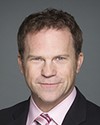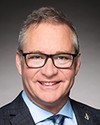Thank you, Mr. Peers. I have to end it right there.
Mr. Champoux, you have the floor for six minutes.
Evidence of meeting #10 for Canadian Heritage in the 43rd Parliament, 2nd session. (The original version is on Parliament’s site, as are the minutes.) The winning word was pandemic.
A video is available from Parliament.
Liberal

The Chair Liberal Scott Simms
Thank you, Mr. Peers. I have to end it right there.
Mr. Champoux, you have the floor for six minutes.
Bloc

Martin Champoux Bloc Drummond, QC
Thank you, Mr. Chair.
Thank you very much to the witnesses for appearing before the committee today to help us with this study.
I would like to speak with representatives of the Fédération culturelle canadienne-française. I want to thank Mr. Théberge and Ms. Morin.
Ms. Morin, you spoke earlier about the difficulties that the people you represent have had in accessing the arts and culture emergency fund during the pandemic. I'd like a little more information on that.
Can you tell us what went wrong and how your intervention helped to rectify the situation?
Executive Director, Fédération culturelle canadienne-française
Thank you for your question.
The funding access analysis revealed a weakness in the application of what might be called an “official languages lens” on investments. The $500-million emergency fund was divided into two phases. It was built on existing funding channels. Our organizations on the ground had very little presence in the channels identified for phase 1. The channels that did not exist were the official languages support programs. Obviously, this had the effect of excluding several organizations of the Canadian francophonie from the funding channels, since they were not there.
Fortunately, things were rectified in phase 2. Teams within the ministry worked with us to find solutions. An announcement was made at the end of August, and we received a special envelope of just over $1 million. This allowed official language minority communities and equity groups, among others, to access this funding. If we look at the way the majority of our groups accessed phase 2 funding, we can see that they did indeed go through the official languages support programs. This certainly met a need. Even though this equity objective was superimposed, the fact remains that our groups had to scrabble hard to obtain some funding.
In British Columbia, Ontario and Acadia, some small cultural presenters still do not receive funding because these organizations do not have an exclusive cultural mandate. Among the criteria defined for the funding envelopes, there was a requirement that there be an exclusive mandate in culture. However, this is an uncommon reality in our country. We have organizations in a minority environment, which are in remote areas and have several hats. For example, some cultural centres provide a daycare service with their activities. These players have been excluded from funding. Clearly, the criteria for granting emergency funding ignored some of the unique characteristics of our small groups operating in fragile environments.
Bloc

Martin Champoux Bloc Drummond, QC
There are a number of actions that can be described as priorities, but which ones would you like to see implemented as quickly as possible and which would have beneficial structuring effects for the sectors and communities of the Canadian and Acadian francophonie that you represent?
Executive Director, Fédération culturelle canadienne-française
I would say two things. The first is that we're going to have to adjust this official languages lens in the machinery of government and make sure it's rigorously applied. In the economic statement presented earlier this week, an additional $181.5 million was announced for the sector. This is certainly welcome. There is a consensus that this pandemic is not over and that the cultural sector will continue to need this support. We will therefore need to ensure that this lens is applied to future investments. This means targeting the programs in which our groups are present and taking into account the realities in the funding criteria. That's the first thing.
Secondly, I'm going to pick up on what my colleague Mr. Pfeifer said. For us too, the digital dimension is important, and our sector is lagging behind in this regard in the Canadian francophonie. Access to broadband is also a challenge in many remote communities. The computer stock and equipment are difficult to renew. There are very few sources of funding to do this. In addition, in general, in the Canadian francophonie, there is a lack of French-language assets and expertise in the field. Not all organizations have the capacity to implement these new digital ways of doing things.
This leads me to say that, for us, there is a real need for investment in this area, but we also need accompanying measures to help organizations make the shift. Finally, there is a need for a digital strategy that is specific to the realities of the arts and culture sector in the francophonie.
Bloc

Martin Champoux Bloc Drummond, QC
I'll turn to Mr. Théberge.
In your presentation, you spoke about historical systemic inequities. I want you to elaborate on this. I don't want to provide the answer for you. However, I imagine that, when you talk about this, you're referring to the fact that francophone communities outside Quebec are often left out of all these programs.
Is that right?
President, Fédération culturelle canadienne-française
You're right. However, my colleague Mrs. Morin touched on this issue in one of her answers. The inequity stems from the fact that funding is provided to existing organizations according to very specific arts and culture criteria. These criteria often don't align with our organizations. Our organizations align more closely with the official languages measures.
As Mrs. Morin said, an organization that operates a daycare centre, that provides after-school French classes for parents or that runs day camps, meaning an organization that carries out all types of community activities, doesn't align with several of the arts and culture funding programs. The organization's mandate isn't completely related to arts and culture. This alone points to the historical challenge of trying to align programs very specifically with the activities of the organizations. As a result, our organizations end up being funded by the official languages support programs.
We're often told that our contacts are the people responsible for official languages support programs. However, we do more than this.
Liberal

The Chair Liberal Scott Simms
Folks, my rudimentary math skills tell me that we're going to extend by five minutes, based on what I have left. I hope I can receive the blessing of the committee to extend five minutes past the top of the hour—or the bottom of the hour, if you're in Newfoundland.
Ms. Morin, when you speak again, could you please hold the microphone closer to your mouth?
As a matter of fact, up next we have Ms. McPherson. She'll show you exactly how to do it. Go ahead, Ms. McPherson. You have six minutes, please.
NDP

Heather McPherson NDP Edmonton Strathcona, AB
I will start with a demonstration of holding my mike up, I suppose.
Thank you, and thanks also to all our witnesses today. It's been very interesting.
I get the great privilege of going after my colleague, so I can sort of fill in the gaps in questions that may have been there.
It would be remiss of me as an Albertan to not start with Mr. Peers and the Calgary Stampede. I'm not a Calgary member of Parliament, but I can tell you that this has not stopped me from attending the Stampede a number of times. Your hockey team is not as good as ours, but your Stampede is vastly superior.
One of things my colleague Mr. Louis spoke of that I would like to follow up on is the deep impact on the community. We know the Calgary Stampede is not something that happens on the Stampede grounds alone. It happens in the entire province, and certainly massively in the entire city of Calgary.
Do you have some of the numbers of what the impacts have been? Do you have some actual facts on what that impact looks like in a normal year?
President and Chairman of the Board, Calgary Stampede
If we compare with a normal year, what I would say is that here in the province, the economic benefit of the Calgary Stampede throughout the year is about $540 million, so as we've been drawn to, really, zero over the course of the pandemic here, it has had a huge impact on what we would normally be seeing in the province.
NDP

Heather McPherson NDP Edmonton Strathcona, AB
Hopefully there will be a rollout of a vaccine and hopefully we will be able to have a Stampede in 2021. One of my concerns as we go forward is whether people will be comfortable attending the stampede. Do you have worries about what that will look like in terms of participation?
President and Chairman of the Board, Calgary Stampede
We're certainly aware that this is going to be an element that will have to be addressed. What I can say is that in the short period of time that we were allowed to open some of our events here in October in Stampede Park, in terms of our convention facilities and meetings and trade shows, there was definitely a demand. People wanted to get back out and participate, and I would hope that's going to be the same come July.
NDP

Heather McPherson NDP Edmonton Strathcona, AB
Well, if it's possible, I can tell you that I will be there, and perhaps, Mr. Chair, could I suggest a field trip for the committee?
NDP

Heather McPherson NDP Edmonton Strathcona, AB
We could all visit. I'll host.
For my next question, I think I'll go from one fantastic festival in Alberta to another.
I'm from Edmonton Strathcona, which of course I've said in the previous panel. We have a massive francophone community, and so I'd like to ask some questions of Ms. Morin and Mr. Théberge.
In terms of equitable access and support for the francophonie outside of Quebec in other areas of the country, I know you've given us quite a lot of information, but could you please give us your top three recommendations for the federal government that we can take forward to the government right now? What would those three things be?
Ms. Morin, I'll start with you.
Executive Director, Fédération culturelle canadienne-française
As I said earlier, my first recommendation would be to systematically apply the lens for upcoming and future investments; to clearly understand how our organizations are funded on the ground; and to ensure that the affected envelopes and programs target a sufficient amount of francophone organizations in the sector and that the organizations are funded fairly.
My second recommendation would be to make digital investments to ensure support. It isn't enough to have funding for digital projects. Our organizations and artists must also receive assistance with this digital shift. Even though Canada has a digital strategy or wants to allocate funding to this area, we need people, “digital officers”, to help our organizations structure their activities and their artistic approach in this digital shift.
My third recommendation would be to ensure that all arts and culture organizations across the country have systematic access to the allocated funding; a systematic way to transfer money with specific conditions for equity groups; and performance indicators to track the progress of this funding.
NDP

Heather McPherson NDP Edmonton Strathcona, AB
Thank you.
Is there anything that you would like to add to that, Mr. Théberge?
President, Fédération culturelle canadienne-française
The only thing that I'd add to what Mrs. Morin just said is the underlying issue of data. We had to conduct our own research to determine the number of jobs, the investments and the benefits of our work.
To ensure that we can answer your questions properly and that the government can effectively and efficiently allocate its funding and run its various programs, you must address a current shortcoming. We need access to data that has been properly collected, verified and assessed.
Liberal

The Chair Liberal Scott Simms
Thank you, Ms. McPherson.
Mr. Aitchison, you have five minutes, please.
Conservative

Scott Aitchison Conservative Parry Sound—Muskoka, ON
I must admit I feel a bit at a loss for words. A lot of the questions I was thinking of have been asked and answered. As a result of that, I'd like to focus a bit more on the performing arts that Mr. Pfeifer was speaking about.
Specifically, I'm wondering, Mr. Pfeifer, if you could elaborate a bit more on it. Also, has there been any formal application process or anything commenced by your organization to request support for the construction of that facility?
Executive Director, Qaggiavuut! Nunavut Performing Arts Society
Thank you very much, Mr. Aitchison. I appreciate the conversation we're having and your question in particular.
Yes, our performing arts centre concept has gone through a couple of years of really purposeful study. We've made substantial investments in going through that process. For example, we developed a feasibility study and spent a year of consultation with all sorts of different levels of stakeholders. At one point, there was interest from a federal minister of Canadian heritage. That was really starting to signal a potential upswing in very necessary tripartite investments with different levels of government.
The political investment climate at the moment is usually that within the federal family there is interest and appetite in filling this Canadian gap, as I was espousing. The trouble with the territorial government is that there is this management by crisis. A lot of the necessary operating and investment programming dollars goes just to handle crises. About 60% to 70% of its budget is just to deal with crises in health, education and transportation, so what is left over to invest in legacy projects such as the Nunavut performing arts centre?
Dollars to donuts, this performing arts centre would have tremendous return on an investment. It would signal that Nunavut and Iqaluit are a cultural Mecca where people all over the world can come—safely, of course.
When you have something that's concrete, that's a bricks and mortar place like this, it's akin to building a university. We don't have that here either. The point is, sir, that it's really about the momentum we've been building. It has been a wonderful opportunity to be able to share it with you.
Lastly, my point is that this infrastructure investment really is about tying in the work we're doing at the school with performing arts nationally and internationally. Again, it's this homegrown generational effort. I think you would agree that the performing arts are an incredibly important panacea, perhaps, in growing the next generation of self-actualized, healthy Inuit.